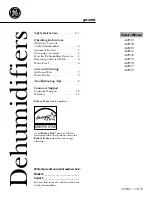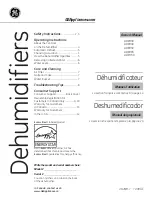
Humidifiers
www.carnes.com
G-9
Humidifiers | Steam Humidifiers
APPLICATIONS
COMFORT
Temperature and relative humidity affect the comfort and
well being of all living things. High temperatures require
low humidity to maintain comfort conditions, while low
temperatures can more easily be tolerated at high
relative humidity. Humidification occurs when air is
moisturized by a humidification unit or when hygroscopic
materials (materials containing moisture) lose moisture
to drier air. Proper humidification is widely accepted as
healthy, minimizing employee illness and lost work time.
MATERIALS STORAGE
Paper, fabrics, wood, plastic, chemicals and most other
materials are hygroscopic. Their water content depends
on the humidity of the air around them. If air is too dry,
these substances lose moisture until an equilibrium is
reached between hygroscopic materials and the air.
PROCESS
Process operations, such as data processing areas, are
affected by two major humidity factors:
hygroscopic
material and generation of
static electricity
.
Hygroscopic
material used in the process influences
material weights, dimensions
and
workability.
Static Electricity
can totally disrupt high speed process
operations as found in a data processing center, paper or
film handling business. Created by friction between two
substances, static electricity can be prevented by proper
humidification of the process environment.
OPERATION
Upon a signal from external controls the circuit board
opens a fill solenoid valve, allowing water to flow across
an air gap into a standpipe. The standpipe provides a
column of water to be fed into the cylinder using gravity.
The air gap prevents back flow into the water supply
and prevents the cylinder from becoming a pressure
vessel. The steam cylinder operates at a pressure of
approximately 1/2 psi.
The circuit board also closes a power contactor allowing
current to flow to vertical electrodes sealed inside the
cylinder. Current flows between the electrodes using
minerals in the water as a conductor. The water is
heated to boiling and converted to steam which leaves
the cylinder through the flexible steam hose which is
connected to the steam distributor pipe.
The circuit board reacts to current flow between the
electrodes and automatically opens the fill solenoid valve
when more water is required to maintain the desired
output rate, and closes when the desired rate is
reached. The operation of the drain solenoid valve
is automatically controlled by the circuit board which
responds to any changes in water conditions and drains
the required quantity of water to provide stable operation
and long cylinder life.
As mineral deposits build up within the cylinder the water
level will slowly rise to contact clean electrode surfaces
to maintain the desired steam output rate. When mineral
deposits have covered all available electrode surface
areas, current flow will be reduced to a level where the
desired steam output cannot be reached and the service
light will signal the need for maintenance. When the
cylinder is filled with minerals it is easily changed in less
than five minutes.
APPLICATION
TEMP F°
RH %
Computer Rooms
72+2
50+5
Office Buildings
70-74
20-30
Libraries & Museums
68-72
40-55
Archival Libraries & Museums
55-65
35
Art Storage
60-72
50+2
Stuffed Animals
40-50
50
Bowling Centers
70-74
20-30
Health Facilities
Full Term Nursery
75
30min.-60max.
Special Care Nursery
75-80
30min.-60max.
Patient Rooms
75
30
Intensive Care
75-80
30min.-60max.
Operating Rooms
68-76
50min.-60max.
Recovery Rooms
75
50min.-60max.
Lasik Eye Centers
Electrical Instrument Mfg.
70
50-55
Fur Storage
40-50
55-65
Photo Film Darkroom
70-72
45-55
Photo Print Darkroom
70-72
45-55
Photo Drying Room
90-100
35-45
Photo Finishing Room
72-75
40-55
Cellophane Wrapping
75-80
45-65
Animal Laboratories
Mouse, Rat
64-79
40-70
Cat
65-85
30-70
Dog
65-85
30-70
Primate
65-84
30-70
Clean Rooms
67-77
40-55
Printing Plants
Lithography
76-80
43-47+2
Rotogravure
45-50+2
Collotype
80+2
85+2
Platemaking
75-80+2
45+2
Telephone Terminal Rooms
72-78
30-40
Radio and TV Studios
74-78
30-40
+ = plus or minus
RECOMMENDED TEMPERATURE AND HUMIDITY
RANGE -
Table 1
Reprinted with permission of the American Society of Heating, Refrigerating
and Air Conditioning Engineers, Inc., Atlanta, GA 30329.
Steam
Distributor
Pipe
Steam
Hose
From Power
Contactor
Cylinder
Vertical
Electrodes
Drain
Solenoid
Valve
To Drain
STEAM
WATER
Air Gap
Fill
Solenoid Valve
Non Contact
High Water
Sensor
Figure A
Stand
Pipe
Overflow
Tube










































